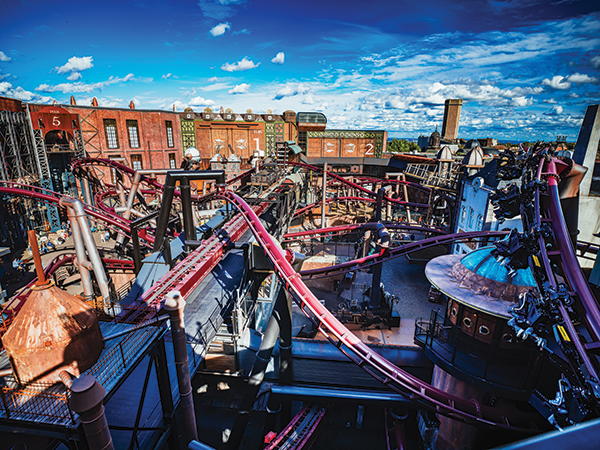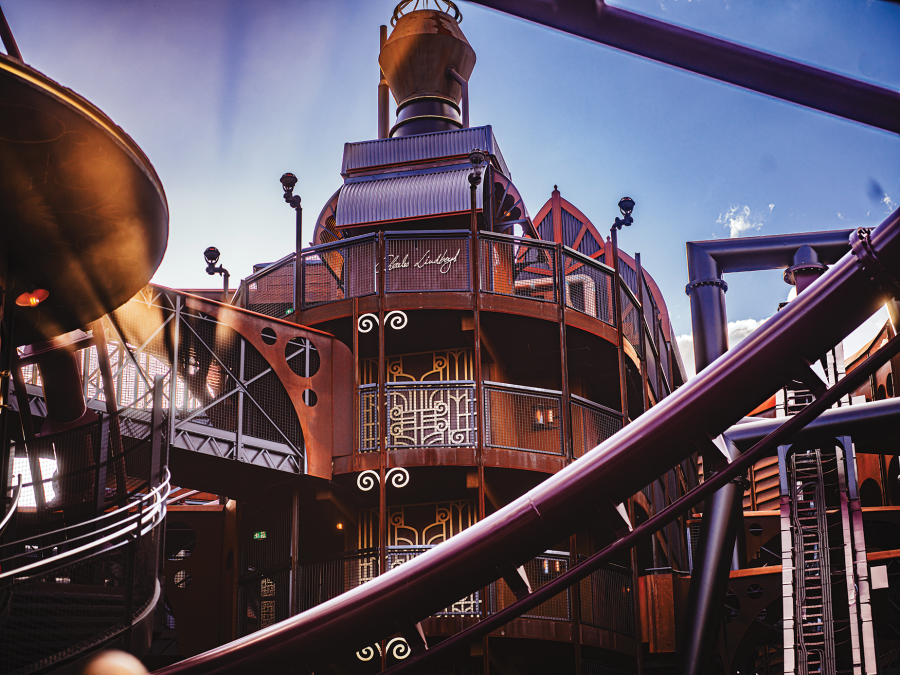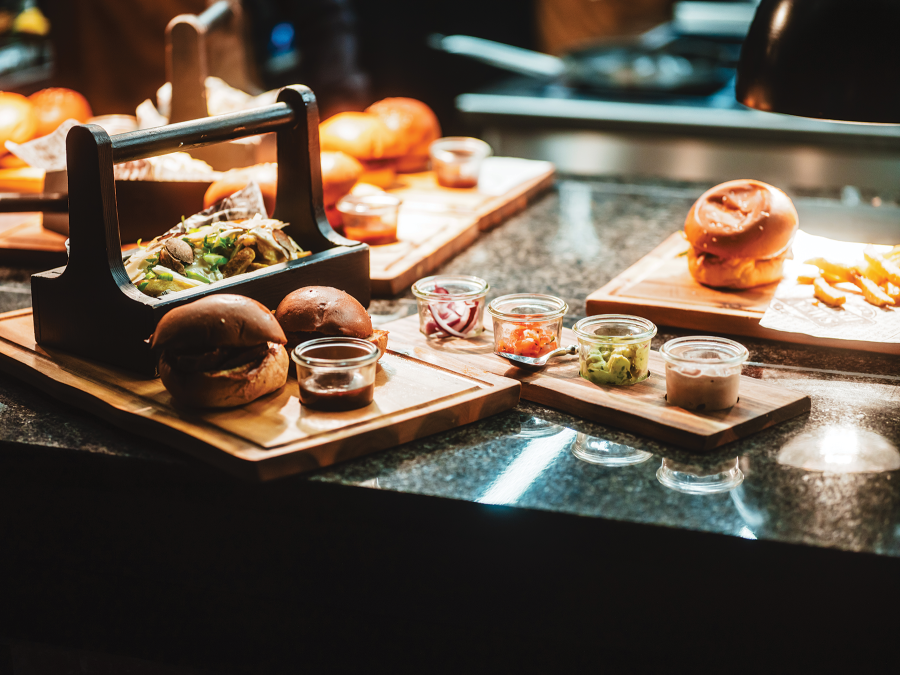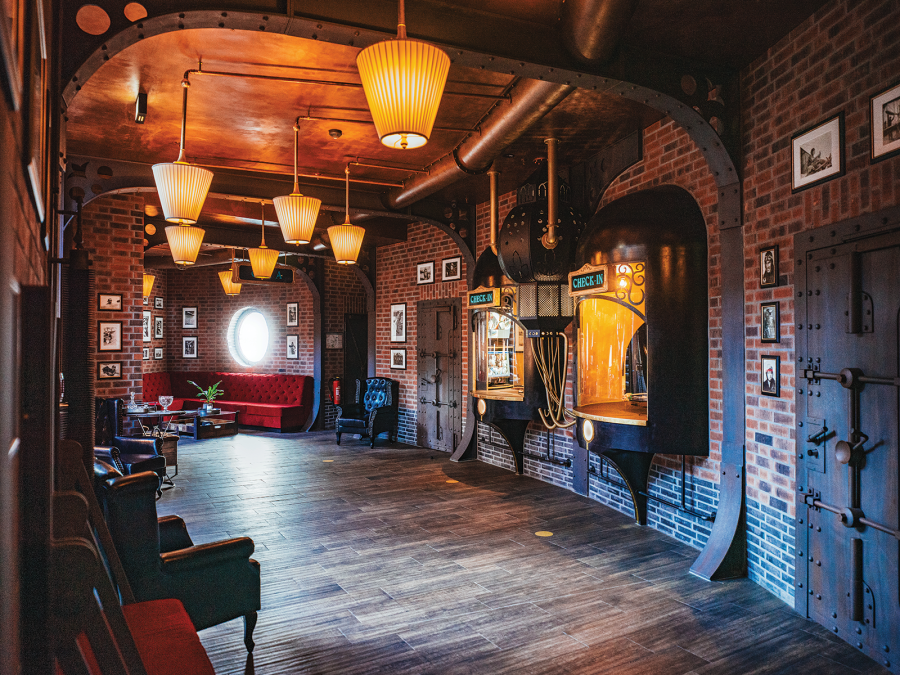Airships levitate in their docking bay overhead. A steam train waits to cross an elevated trestle. Roaring ’20s roadsters are customized with exaggerated headlamps and exhaust pipes. Grounded hot air balloons appear to be generating power. A kinetic flying machine soars overhead before disappearing underground. A palette of brick, rust, iron, and copper pop against autumn’s pristine blue sky, while authentic German cobblestones rest under guests’ feet.
Is this steampunk come to life? The return of the industrial revolution? Or a futuristic world rooted 100 years in the past? The answer is different depending on how each visitor interacts with Rookburgh, an immersive land that elevates the bar on design and the guest experience at Phantasialand in Brühl, Germany.
Rookburgh, along with a hotel embedded inside the land, is the vision of Robert Löffelhardt, Phantasialand’s innovative owner, and the product of his dedicated team that spent nearly half a decade crafting the themed, immersive environment.
Redefining Design
From the start, Löffelhardt’s direction for Rookburgh was clear: Work together as a team, dare to be different, push through barriers, and don’t worry about hitting an opening date. The result is a layered space several stories tall that took four years to build and, as a result, shatters the conventional.
“It gives me the feeling that this is not a themed zone—it’s real life,” says Annette Pieck. As Phantasialand’s manager of construction and projects, Pieck studied steel structures such as the Eiffel Tower, the Köln Hauptbahnhof railway station, and 100-year-old bridges in Germany for their aesthetic and texture. She then applied their visual language to structures in Rookburgh, creating what feels like a movie set. Here, employees don’t wear uniforms; they display what the park calls “fashion.” Scenic elements and audio cues abound around each corner, right down to white steam spewing from strategically placed vents. In Rookburgh, trees and grass are replaced by stretched factory windows and avenues lined with piles of coal. Every last detail contributes to the theme, including the surrounding walls of the world, which envelope the visitor in a way that prevents any outside influence from seeping in and compromising the story.
Advancing Operations
Coiling through the center of Rookburgh is a revolutionary flying roller coaster sporting two launches. Guests ride “F.L.Y.” in a flying position, with their chests and knees horizontal with the ground (except when they’re inverted by the coaster’s two corkscrews). Like the dedication of an inventor destined to find success, a flying coaster first appeared on Phantasialand’s radar in 2003 and on the drawing board again in 2011, with the latter not providing enough room for the necessary ride specs, according to Phantasialand Park Director Sebastian Jonas.
“This was the ideal theme; it’s a perfect fit for Rookburgh’s industrial look,” says Jonas, a self-described roller coaster aficionado who traveled the globe researching flying coasters.
Steel erectors placed “F.L.Y.’s” first track piece in August 2017 and laid the final piece in April 2019, needing to pause while different levels of the land were built first. The merlot-colored track and gray support columns (adorned in faux rust to add to the theme) cross over and under themselves dozens of times.
“We changed a lot of things in this new generation flying coaster,” Jonas shares with Funworld. That includes a new boarding procedure more akin to a sit-down coaster. “F.L.Y.’s” track is positioned vertically inside the boarding station. Later, the track flips upside down, transitioning riders into the “lie to fly” position while they’re in motion just prior to the first launch.
In addition, “F.L.Y.’s” operators have refined the way to handle loose articles.
“Many coasters tend to have safety nets to make sure that loose items do not fall to the ground. But those nets would totally rob the experience of Rookburgh,” says Jonas.
The park instead adopted an innovative locker system. Once “F.L.Y.’s” queue snakes around corners, down hidden staircases, and past intricate dioramas, operators assign all riders a wristband that opens a free locker. (Each locker features a second door in its rear, aiding in guest flow upon exiting.) Next, riders must pass through a security screening to ensure all loose articles are left behind. “We need to make 100% sure that no loose articles get on the ride—absolutely everything comes out of pockets,” Jonas explains.
By positioning a turnstile at the end of ride—which riders activate by returning their wristband—the park retains each band to be used again. “F.L.Y.” has 15 operating positions, utilizes separate load and unload platforms, and employs four trains to aid in capacity.
“At the exit of ‘F.L.Y.,’ you see nothing but smiles. People want to ride again,” Jonas says.
Immersive Lodging
In the back left corner of Rookburgh, just meters away from “F.L.Y.’s” lift hill, sits a block structure that Pieck best describes as a “generator.” Sprinkled across the façade of building are oversized exhaust ports, which upon further inspection, reveal a functioning door. Each leads to one of the 106 cabins comprising the Hotel Charles Lindbergh, Phantasialand’s imaginative—and off-limits—hotel.
“We were searching for something that is completely different [and] offers a double experience,” says Pieck. “It was very clear from the beginning that what happens in the hotel is only for hotel guests.”
Guests at Hotel Charles Lindbergh (named after the American aviator who was the first person to fly solo and nonstop across the Atlantic Ocean) don’t book a room; rather, they must purchase a two-day adventure package. The experience includes one overnight stay in a vertically stacked cabin, park admission for two days, a three-course dinner, breakfast, admittance to the exclusive 1919 bar, use of the VIP boarding lane on “F.L.Y.,” and access to Rookburgh after dark. Upon arrival, visitors transform into “aeronauts” as they are buzzed through a locked door outside the park’s front gate. A tunnel carrying vintage luggage leads to the arrival desk—crafted to look like oversized vacuum tubes—where new aeronauts are inducted into the Explorers’ Society. Conscious of every detail, the lobby smells of a man’s rugged cologne, as if an explorer has just dashed away to his next adventure.
With a club card in-hand, guests may access Rookburgh directly through a secret entrance. The only way to see the inside of Hotel Charles Lindbergh, and enjoy a cocktail at 1919, is to be a card-carrying member of the fabled Explorers’ Society. (After opening in late September 2020, the mystique of the hotel attracted curious day guests, so much so that Phantasialand had to post a doorman at the backdoor.)
“The reaction of the guests is indescribable,” says Anja Berners, operations manager at Hotel Charles Lindbergh, who tells Funworld that some aeronauts arrive wearing fashion from the 1920s. “There is a sparkle in their eyes.”
Aeronauts do not stay in traditional rooms. Cabins are scattered across different platforms, providing sweeping views close to the coaster. “People tend to need a moment to take that all in,” Berners says.
Inside each cabin, a concave ceiling is suspended above two twin beds. Aviator goggles, flight journals, and the Rookburgh Gazette—a newspaper providing stories of the land’s characters and a dining menu—can be found in the interior space, which also features a private bathroom with floor-to-ceiling luminescent white tile and a stainless-steel sink and toilet.
The design team first built three mock cabins in an employee-only area where staff members provided feedback during their lunch break on mattress configurations. Pieck says the park recognizes the interior living space is tight.
“We said, ‘Yeah, it is what it is. It should be possible for two adults to sleep at least one night in two separate beds,’” Pieck shares.
A proposed white fitted sheet felt out of place in the cabin environment. And when a gray sheet failed to keep its color after several washings, Löffelhardt empowered the team to source a new alternative.
“Now, the sheets are especially made for us. The quality is such that the color stays the same,” says Pieck. “We invested time, energy, and money on getting special things only made for this hotel.” That also includes locating the right soap. With a scent of lavender and peppermint, the chosen soap hails from one of the oldest pharmacies in New York City.
“They always take the not-so-easy route,” explains Friso de Jong, head of international marketing and sales, of how Phantasialand’s decision-makers strive for perfection. “We always go one step further and ask, ‘Can you make this for us?’”
Innovative Food and Beverage
Developing Rookburgh for all senses included creating a dynamic food and beverage program.
“We felt if you see it and feel it, you also have to eat it,” says Nana David, head of the park’s food division.
“Everything has to match the other. This was important for us.”
At Restaurant Uhrwerk, located adjacent to Hotel Charles Lindbergh, silverware is brought to the table in a tin bucket; miniature black shovels best suited to shovel coal are used to serve five different medleys of french fries; and a poke bowl is served in a small pot with handles on the side. Burgers are presented on a wooden cutting board, separated by a sheet of newspaper print; toppings arrive in four glass cups resembling beer flights. And salad dressing arrives in a 19th century milk bottle.
“The bowl and that pot feel very gritty and urban-like,” says David. “Everything here has to match each other.”
When she could not source the perfect buns for the grilled sandwiches at the quick-serve Zum Kohleschipper, David approached a local bakery and shared her vision. Today, the vendor bakes three kinds of fresh bread to complement each sandwich. Likewise, when the lack of quality pasta was keeping David awake at night, Löffelhardt encouraged her to source it directly from Italy. Confections made inside Emilie’s Chocoladen- & Candy-Werkstatt use chocolate from Belgium and Italy.
David’s advice: “Of course you can have a great looking surrounding, a great setting … but don’t spare costs on ingredients.”
That includes grilling meat and fish directly in front of guests at Zum Kohleschipper. David admits made-to-order takes time to prepare but believes European guests are willing to wait 10 minutes for a high-quality, fresh sandwich.
Inside the exclusive 1919 hotel lounge, the selection of 15 beers on tap included creating a special dispensing unit for bartenders to use as theater.
“Our bartenders really go out of their way to explain the story behind each beer with much enthusiasm and flamboyance,” Berners says.
Mixed drinks are sold in oversized cocktail bowls, lavishly decorated with sweets and dry ice. “There is a wide range of variations and colors—with or without alcohol—so there is something for everyone,” Berners shares.
Emblematic Evolution
For Pieck, Rookburgh may never be done. Additional themed elements sit on her desk, waiting to be installed.
“I’m just looking for the best moment to add it because we never stop,” she says. Pieck reevaluates the use of certain materials, signage, and themed elements. Like Rookburgh’s symbolism celebrating humankind’s desire to stretch, grow, and explore, Pieck hints there’s more innovation ahead for Phantasialand.
“We were constantly trying to get better.”
- Scott Fais is IAAPA’s managing editor of global communications and digital content. Contact him at [email protected].
Visit IAAPA.org/RookburghPhotos to see additional photography from Funworld’s cover shoot inside Rookburgh.
To watch the Rookburgh cinematic trailer, visit IAAPA.org/RookburghFilm, and for a video walkthrough of a cabin at the Hotel Charles Lindbergh, visit at IAAPA.org/Lindbergh.




